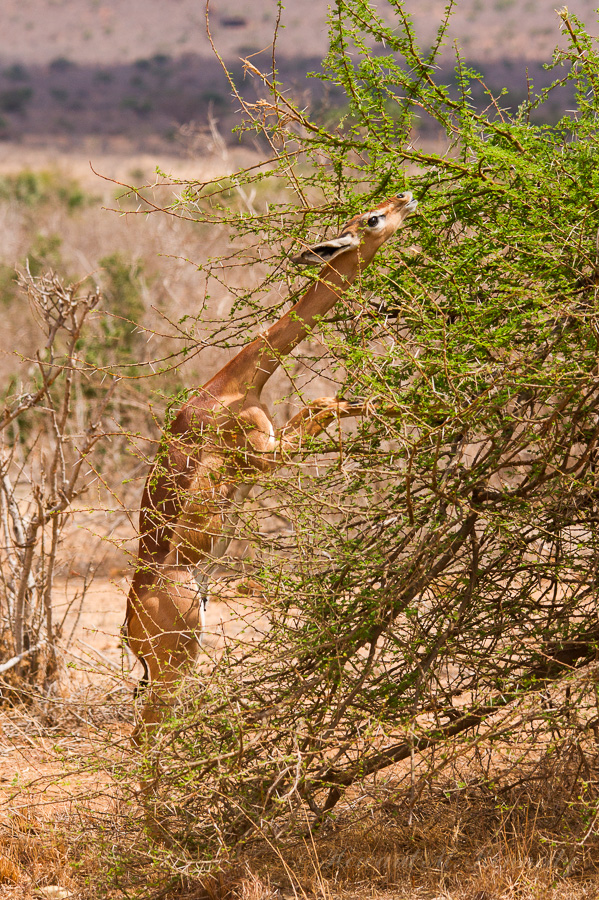

8th to 22nd September 2019
| The sign at the main gate to Tsavo East National
Park, at Voi in Kenya, proclaims the "Theatre Of The Wild". Not only is
this not an exaggeration, it is an
understatement! In twelve years of visiting Tsavo, it has never failed
to completely overwhelm us with the variety and quality of wildlife
viewing and photography opportunities this incredible place provides. Many people on organised safaris have been rushed through Tsavo East in a day and been bored with its vastness and disappointed by seeing little of the wildlife that lives there but spend more than a day or two in this breathtakingly wild place and you soon realise that this is not a safari theme park, is is a true wilderness the size of Wales and if you let her share at her own pace, Tsavo will reward you handsomely. |

| We begin our safari in Tsavo East National Park, the largest and most arid part of the Tsavo Ecosystem, which includes the Taru Desert. We will spend four days in this amazing place, visiting stunning locations and photographing the incredible variety of life here, which includes several desert-adapted species not found in most other parts of Kenya. |


| Most people are unaware that Tsavo is home to one of the most important populations of Cheetah remaining in the wild. Namibia is home to the largest population of Cheetah but Tsavo has the largest East African population, so the whole Tsavo ecosystem is a vital Cheetah research area. |


| In Tsavo East National Park, we will stay in Ndololo Safari Camp, a rustic lodge with fixed tents. Each tent has its own shower and flush toilet plus a double bed with mosquito net. The lodge is not fenced, so the wildlife is free to come and go. It is not unusual to find wildlife travelling right through the camp, especially at night, so night-time wanderings are not recommended! (although infra red camera traps placed outside your tent can sometimes provide fascinating viewing over breakfast) |

| After four nights in Tsavo East National Park, we will head out but we will not be leaving Tsavo. Our next destination is Ngutuni, a 45 square kilometre private game sanctuary that shares a border on three sides with Tsavo East National Park. The border is unfenced and wildlife is free to move between the National Park and the sanctuary. Nugutuni has a beautiful lodge with spacious and comfortable rooms that each have a balcony overlooking a waterhole. The lodge bar also has a terrace that reaches out towards the waterhole. At night, over dinner, you may well be serenaded by the rumblings of Elephants in the waterhole, or Lions calling out their territorial challenge: "WHO rules this land? I do, I do, me, me, me". |


| The waterhole at Ngutuni attracts wildlife from far beyond the borders of the sanctuary and often huge herds of Cape Buffalo, Elephant and Zebra will visit. The diversity of wildlife here is quite astounding and takes most westerners by surprise, accustomed as we are to the decimated wildlife levels of our own countries. In 2016 we spent a "lazy person's safari" sitting on the terrace all day at Ngutuni and counted 84 different species of animal and bird in just one day! |



| We will take morning and afternoon game drives
in the sanctuary, which can throw up some surprising sightings. Watch
out particularly for Lions, Jackals and even rare
day-time sightings of
Aardwolf! In between game drives, enjoy the relaxing atmosphere of the
bar terrace with a cup of tea, coffee or a cold Tusker beer, whilst
keeping your camera handy for anything coming into the waterhole. Tsavo is home to the descendents of the infamous "Maneaters of Tsavo". These were two huge male Lions who devoured dozens of workers building the Tsavo River Bridge for the railway line between Mombasa and Uganda in the late 1800s. When the maneaters were eventually killed, they were found to be very large males without any mane (the stuffed corpses are currently on display in the Chicago Field Musem but Kenya has requested their return). Tsavo is the only place in the World where maneless male Lions are as common as maned Lions. Unlike Lion prides elsewhere, in Tsavo the male Lions hunt and do not leave that to the females. One pride we tracked in Ngutuni to their Buffalo calf kill consisted of three full adult maneless males, four sub-adult males and two females. |

The male Lions in this pride, guarding their Cape Buffalo Calf kill, are maneless
|


| Tsavo West National Park is quite different to
the more arid east, with steep hills, lava flows and the striking oasis
of Mzima Springs. Within the park is a large area enclosed as a Rhino
sanctuary, where Black Rhino are allowed to breed in increased security
before reintroduction to the park and other reserves in Kenya. As we
drive over the Chaimu Lava Flow towards Mzima Springs, you may see the
towering majesty of Mount Kilimanjaro, 50km away in Tanzania on a clear
day. During our three days in Tsavo West, we will visit Mzima Springs, the Rhino Sanctuary, Kuldip's Ponds and circle the Rhino Valley in search of wildlife. The lodge itself is situated within the territory of a female Leopard, so we may find her if we are lucky. Leopards are notoriously difficult to spot but here we will have as good a chance as anywhere. You will also have the chance to take a walking safari and even learn some traditional skills with the lodge Askari. |






Masai Giraffe Bulls fighting in Tsavo West National Park
| From Tsavo West National Park, we will head north towards Nairobi, with an overnight stop at Hunter's Lodge, near Kiboko. This lodge has a unique and bloody part in Kenya's colonial history. The area was a stronghold of the Black Rhino but the colonial government wanted to move the Kamba people off their land and resettle them here. Scottish big game hunter J.A. Hunter was tasked with eradicating the Black Rhino from the area and he did so with such gusto that he slaughtered 996 in just over a year. Hunter's Lodge was built by his son in the area as a family hunting lodge and later became an hotel. It sits on the banks of the Kiboko River, with numerous bird species and a resident troop of Vervet Monkeys. In 2015 Hunter's Lodge was completely refurbished. |


| After a relaxing night at Hunter's Lodge, we
will continue north to Nairobi and the hotel where we will spend the
remaining evenings of our safari. In Nairobi, we will spend two days
exploring Nairobi National Park, the only place in the World where you
can photograph wild Lions and Rhinos with the backdrop of a modern
metropolis. Our final day will include a visit to the Sheldrick Trust Orphanage and the National Museum of Kenya. The orphanage was set up by Dame Daphne Sheldrick, who was the first person ever to devise a milk formula suitable for baby Elephants and then the same for baby Rhinos. Here the Keepers will tell you all about the babies and how they came to be orphaned. You will also get very close to the babies and be able to photograph them during their daily mud-bath. The National Museum of Kenya is an essential stop for everyone visiting this amazingly diverse country. Specimens of every species of mammal and bird (1084 species of bird!) feature in the collections, making it a great place to identify those many species you have photographed on your safari. Other exhibits include the earliest hominids found in Oldovai and Turkana by the Leakeys. After one final night in the hotel, we head for the airport and our flights home. |


Lion in Nairobi National Park

Keeper feeding one of the Elephant orphans at the Sheldrick Trust Orphanage
| The price for this amazing photographic safari
experience is £3,995. A deposit of £1,000 will secure your place, with
the balance of £2,995 due by Friday 12th July 2019. Included in the price are the following: |
|
| What is not included in the price? |
|
| Why take a Safari Experience with us? |
|
| To book your place on our Jewels Of Kenya Photographic Experience, please select from the PayPal options below. |
 |
 |
 |
 |
 |
 |